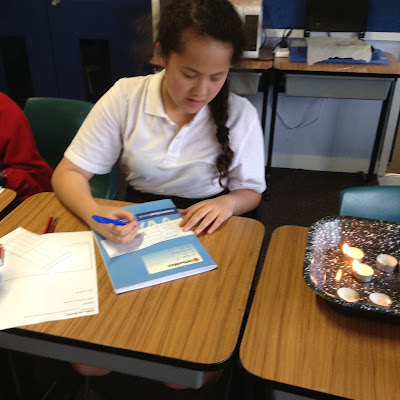Room 10 have been learning about the states of matter and what happens when a candle burns. They now know what a candle needs to burn and they have learnt about changes that take place during burning - physical and chemical, permanent and temporary.
Some good learning took place:
- When paraffin wax is burnt it turns into paraffin gas (I thought it turned into smoke)
- The wick doesn't burn it's the gas that is burning.
- That if you blow out a candle and relight it not by the wick by smoke.
- What your relighting is that the paraffin that is now a gas
- Candles need oxygen to burn otherwise if it doesn't have oxygen it wont be able to keep the flame going
- Candles burn because of the paraffin and the melting wax mixing with the oxygen and and its a gaseous state
- If you place your hand over top of the burning candles you can feel heat but if you place your hand around the sides you can feel no heat.
- If a candle was to be lit in a space shuttle it will form a spherical kind of shape.
- A candle is normally made of paraffin
- Paraffin is made out of 2 different atoms carbon in the middle and hydrogen around the outside
A KAHOOT was used to test knowledge learnt. Follow this link and try it:
https://play.kahoot.it/#/k/edf858f6-c2bf-4f44-a9b4-d5298dd73c92
To end our study the class conducted investigations:https://play.kahoot.it/#/k/edf858f6-c2bf-4f44-a9b4-d5298dd73c92
Isla and Juliyah investigated whether colour and fragrance affected the rate a candle burns at:
Christian, Caleb and Jared investigated whether a frozen candle burns differently to a candle of room tempertaure: They took observing very seriously!
We found out the frozen candles burnt slightly faster than non
frozen, but the non frozen produced more melted wax than the
frozen candles. The frozen candle had a smaller flame than the non frozen candle.
Isla M and Ivy Jean investigated whether wick size or material affect the way a candle burns.
We learnt that the
thicker the wick the more wax it absorbs. and the different size
wick did affect the flame size.The more wax absorbed the bigger the flame = more fuel.
The thick string
worked the best and the nylon string just shriveled up and died as soon as the flame
touched it.The wool wasn't very good - it only burnt for a little while.
Jadene, Cortney and Keyana investigated whether candle size affects the size of the flame and the rate of burning
We found that the size of the candles doesn't affect how
much wax has burnt. We burnt the candles for the same amount of ime then weighed them, each of the candles had lost 0.1g each even
though they are all different sizes.The
bigger candle had the tallestflame,we think this was because of the wick.
We used candles of the same sizes and burnt them for a set time, we observed the beeswax candles burned faster and brighter
than the paraffin ones.













It is very informative post,
ReplyDeleteClean Burning Candles
Thanks!!!